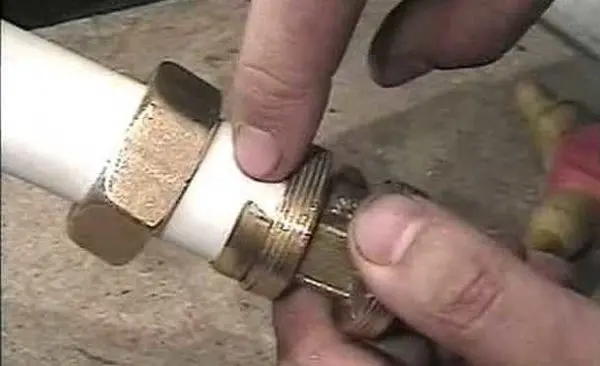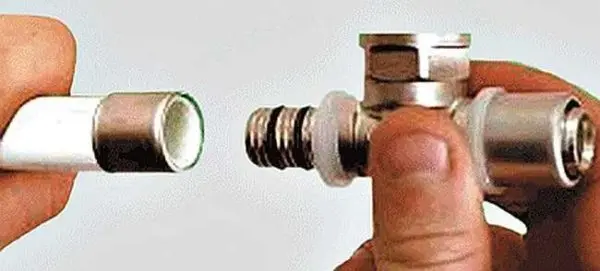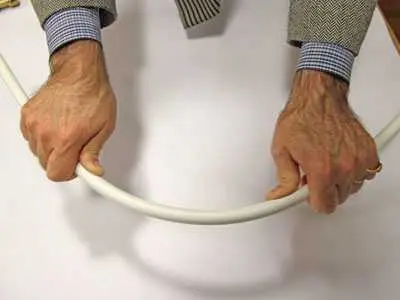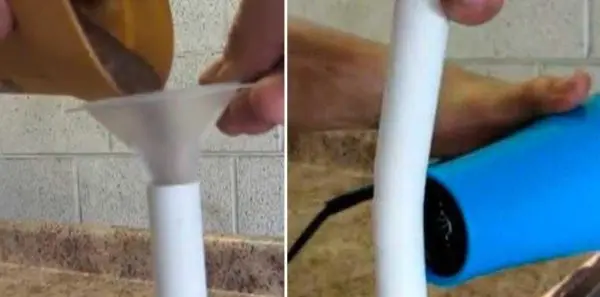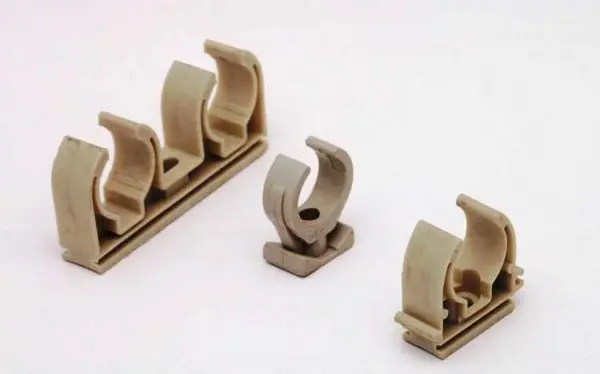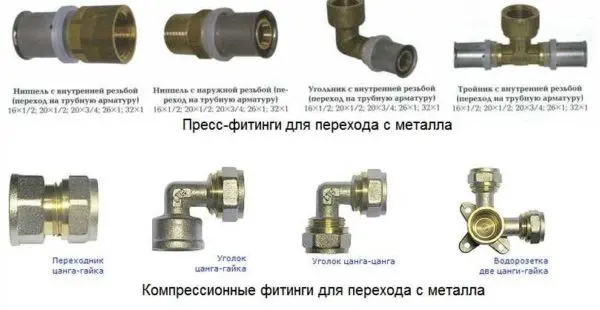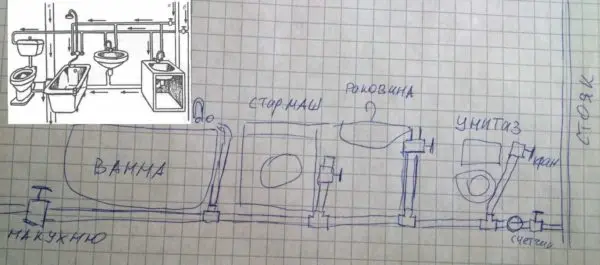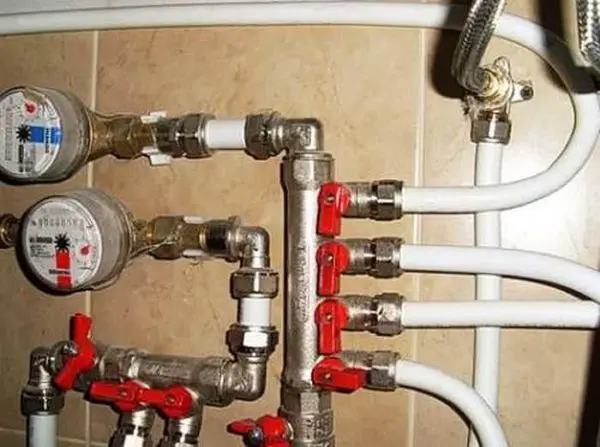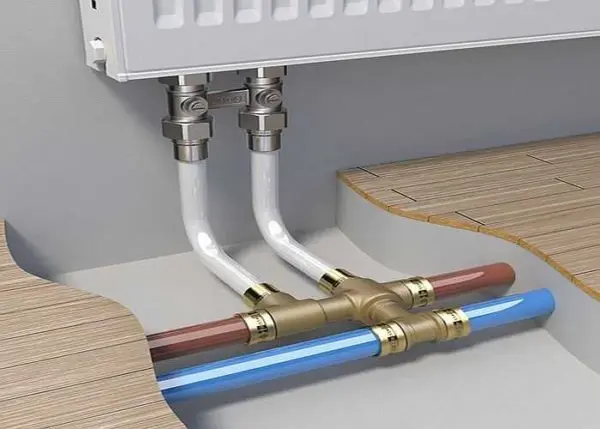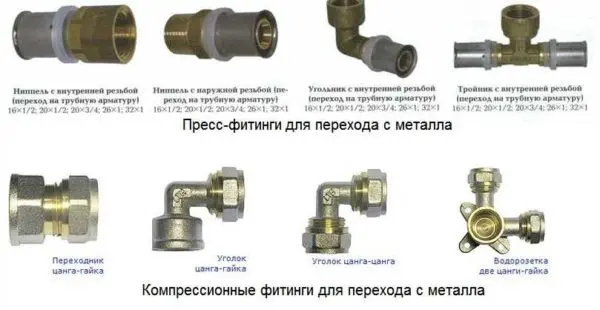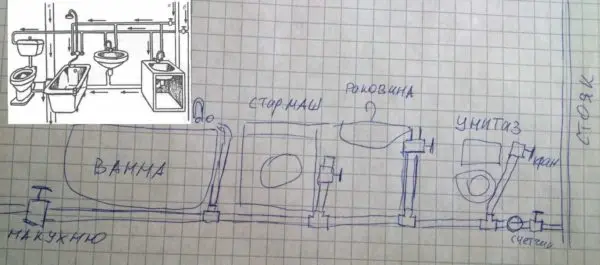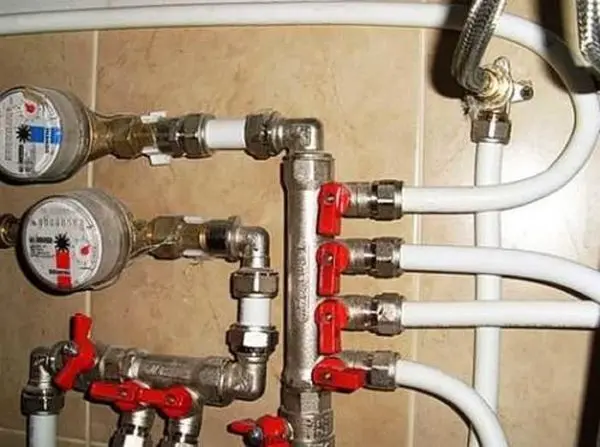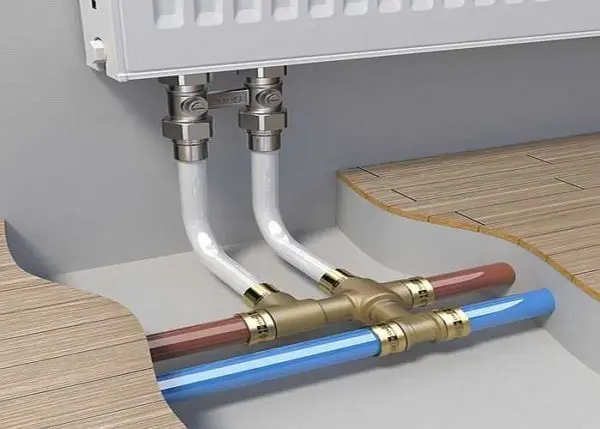Contents
- Types of fittings for metal-plastic pipes
- Preparing for installation
- Installation of metal-plastic pipes using compression fittings
- Installation of crimp (press or push) fittings on MP pipes
- How to bend a metal-plastic pipe
- How to attach to walls
- Non-standard connections: with metal pipes, change to a different diameter
- An example of the layout of the water supply system
Steel pipes are gradually being squeezed out of the market: worthy competitors have appeared that cost less, are easier to install, and serve no less. For example, hot and cold plumbing, a heating system are made of metal-plastic. How to properly install metal-plastic pipes, what fittings to use when, how to use them to connect the segments into a single whole – all this will be discussed.
Types of fittings for metal-plastic pipes
The structure of metal-plastic pipes is such that it is impossible to weld or solder them. Therefore, all branches and some bends are made using fittings – special elements of various configurations – tees, adapters, corners, etc. With their help, a system of any configuration is assembled. The disadvantage of this technology is the high cost of fittings and the time that will have to be spent on their installation.
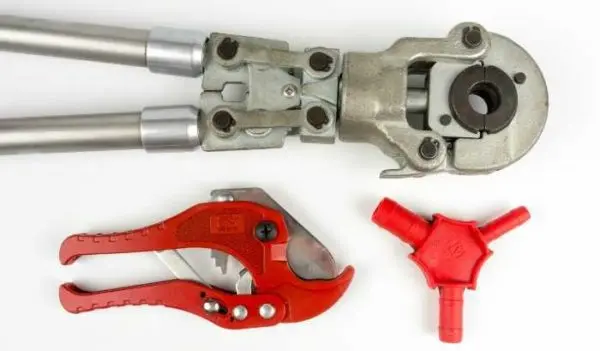
The advantage of metal-plastic pipes is that they bend well. This allows you to use fewer fittings (they are expensive). In general, fittings for metal-plastic pipes are:
- Crimp.
- Press fittings (press fittings).
Deciding which type of fitting to use is simple. Crimps are used for pipelines to which there is always access – over time, connections need to be tightened. Presses can be walled up. That’s the whole choice – you need to know what type of installation of metal-plastic pipes will be in a particular area.
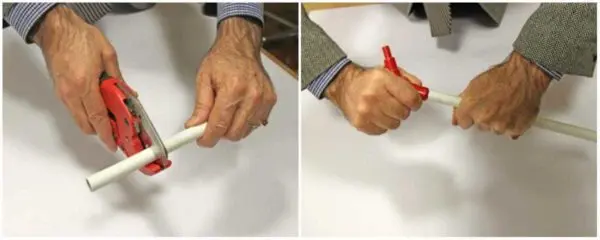
A common drawback of metal-plastic pipes is that due to the design of the fittings at each connection, the pipeline section is narrowed. If there are few connections and the route is not long, this cannot have any consequences. Otherwise, either an increase in the cross-section of the pipeline, or a pump with more power is necessary.
Preparing for installation
First of all, it is necessary to draw the entire plumbing or heating system on a piece of paper. At all branch points, draw the fitting to be installed and label it. So it is convenient to count them.
Tools
To work, in addition to the pipe and purchased fittings, you will need:
Pipe cutter. A scissor-like device. Provides the correct location of the cut – strictly perpendicular to the surface of the pipe. It is very important.
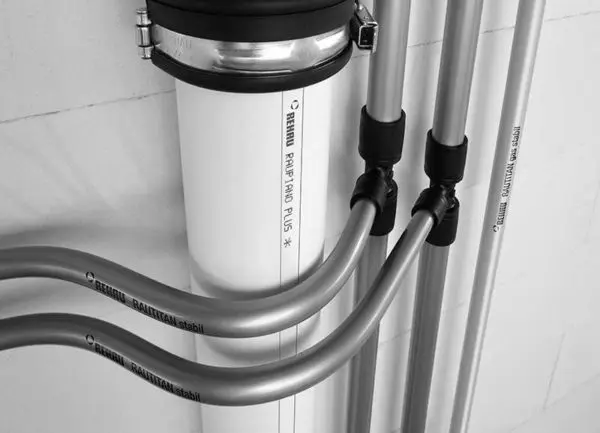
Calibrator (caliber) for metal-plastic pipes. In the process of cutting, the pipe is slightly flattened, and its edges are slightly bent inward. The calibrator is just needed in order to restore the shape and align the edges. Ideally, the edges are flared outward – this way the connection will be more reliable.
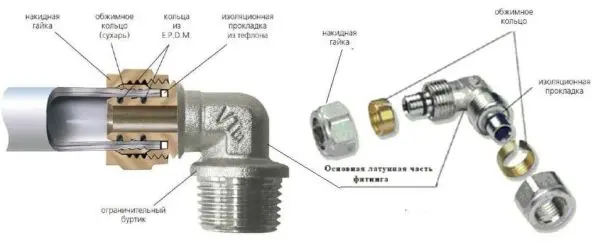
- Zenker – a device for chamfering. A construction knife or a piece of sandpaper will also work. Calibrators often have a chamfering tab, so this tool can be dispensed with.
- Fitting installation equipment:
- for crimping, two wrenches of a suitable size are needed;
- for press fittings – crimping pliers.

Manual crimping pliers or press, MP pipe cutter and calibrator. Actually, this is all the tool needed to install press fittings and install metal-plastic pipes.
Basically everything. Instead of a pipe cutter, you can use a saw with a metal blade, but you will need to make cuts strictly perpendicular to the surface. If you do not trust your eye, take a carpenter’s miter box.
Preparation procedure
Sold metal-plastic pipes of small diameter in bays. Before installation, a piece of the required length is cut off from the bay. In this case, it is necessary to take into account the length that goes into the fitting. That is, it is necessary to cut off a piece with a small margin – 1,2-1,5 cm.
The edges of the segment are inspected if there are burrs (they do not happen when cutting with a pipe cutter, this is a drawback when cutting with a saw), they are leveled. Next, with the help of a beveler or a piece of sandpaper, they chamfer – grind the plastic at an angle both inside the pipe and outside.

Cut, calibrate, chamfer After that, they take the calibrator, forcefully driving it into the pipe and turning it, align the geometry, at the same time straightening the edges “crushed” inward. After that, you can proceed with the installation of metal-plastic pipes and the installation of fittings.
How to align a piece of metal-plastic pipe
As already mentioned, this type of pipe goes in bays, that is, they are twisted. Having cut off a piece, with your hands you straighten it a little, but how to achieve perfect evenness. This is important if the pipeline installation is open. The recipe is simple:
- Find a flat board or piece of chipboard, plywood, etc.
- Wrap the segment to be leveled in a soft cloth (you can use an old terry towel).
- Roll out on the board, leveling.

Usually, when laying a water pipe, in some places the route has to be bent, in some places straight sections should be laid
After the segment becomes even, you can calibrate its edges.
Installation of metal-plastic pipes using compression fittings
Compression fittings consist of several parts. The basis is a cast body with a thread. There is also a compression ring that secures a piece of pipe to the fitting and a union nut that clamps the connection. An important detail is the o-ring, which ensures tightness.
This method of installation is good because no special equipment is needed. The second plus is that the connection is collapsible and, if necessary, the fitting can be replaced. If it fails or there is a need to change the configuration of the pipeline. And it’s very convenient.
But there is a drawback: from time to time, a leak occurs on the thread. Everything is eliminated simply – tightening by half a turn. But because of this, all connections must be available and cannot be walled up. It also strains the need to check – it has flowed, it has not flowed. Not everyone likes it.

This is what compression fittings look like The range of fittings is wide: angles, tees, crosses, adapters (from one diameter to another). And all this with different angles, in different diameters.
The installation of metal-plastic pipes on compression fittings begins with the fact that the union nut and the ferrule are removed, and the presence of sealing gum is checked. After that, the assembly actually begins:
- The nut and ring are put on the pipe.
- The segment is pulled onto the fitting until it stops. The emphasis is indicated by a special small protrusion-shoulder.
- The ring is also pulled all the way to the fitting.

Before tightening the nut - The cap nut is tightened. First, by hand, the connection of metal-plastic tubes is tightened with two keys. One holds the fitting body, the second turns the union nut.
That’s all, the installation process of the compression (screw, threaded) fitting is completed. There is only one caveat: if you fill the system with antifreeze, immediately change the gaskets. Those that come with the kit will flow with antifreeze very quickly. Put paronite or teflon. Only they can ensure tightness. In general, for systems with antifreeze, it is better to use press fittings. They definitely don’t leak (if properly crimped).
Installation of crimp (press or push) fittings on MP pipes
Installation of metal-plastic pipes using compression fittings requires special pliers. Some are manual and some are electric. Any are equipped with a set of linings for different diameters. Manual, of course, are cheaper. This equipment does not have to be bought – it will only be needed once. Much cheaper to rent.

Press fitting for MP pipes The press fitting consists of two parts – the body itself and the crimp sleeve. Before connecting the metal-plastic pipes, the cut is prepared. It is the same as when using compression fittings, but the chamfer is removed only from the inside. Next, the procedure is as follows:
- A sleeve is put on the pipe.
- A gasket is installed on the fitting to prevent electrochemical corrosion.
- The tube is put on the fitting – until it stops. There is a hole on the body of the fitting where the end of the pipe should be visible.
- Take pliers in which suitable pads (of the desired diameter) are installed. Pliers are installed close to the edge of the fitting, connecting the press handles together and crimp the part. As a result, two concave stripes should be clearly visible on the sleeve. Their depth should be the same. Once crimped, the fittings can rotate around the pipe.
That’s all, the installation of metal-plastic pipes using a press fitting is completed. Such a joint can withstand pressure up to 10 atm, which is sufficient for most systems. Not suitable only for heating systems of houses with a number of storeys. more than 16. They may have more pressure in the system.
How to bend a metal-plastic pipe
Often, when installing metal-plastic pipes, it becomes necessary to bend the pipe. This can be done by hand or with a spring. It is easier and faster to work with a spring, but you need to buy it (it is inexpensive). The spring is inserted into the pipe and bent in the required direction. The pipe repeats the bend, the spring is removed. It is easy to bend metal-plastic pipes with a spring – no great efforts are required, the actions are easily controlled, it is possible to correct the result.
What is good about this method is that you will not be able to pinch the walls, which happens when excessive efforts are applied in the manual method. It is also not possible to make a steeper bend (with a radius less than the minimum) and compress the walls at the bend by narrowing the flow section.

Spring for bending metal-plastic pipes Hands bend MP-pipes should be gradually. You take it with your hands on both sides of the bend (at the same distance from the center of the future arc), the thumbs support the pipe from below. In this position, begin to lower the edges down, at the same time press up with your thumbs.

Manual bending of metal-plastic pipes With this method, sometimes the pipe loses its geometry from excessive efforts. This negatively affects its throughput. Such areas cannot be placed in water supply or heating. To avoid such situations, the bending point is heated. This can only be done with a building hair dryer. Open flames cannot be used. The heated plastic is easy to bend. At the same time, it does not squeeze (the main thing is not to overdo it).

Methods for bending MP pipes Another way to avoid deformation is to pour sand inside. He will not let the walls shrink.
How to attach to walls
With open laying of the pipeline, it must be somehow fixed on the walls. Usually special plastic clips are used for this. They are single – for laying one line of the pipeline. Commonly used in plumbing. There are double ones – most often they are installed for heating – the supply and return in two-pipe systems run in parallel.

Clips for mounting metal-plastic pipes on the wall These clips are installed every meter (more often). Under each, a hole is drilled in the wall, a dowel of the required type is inserted (selected depending on the type of material from which the walls are made). A large load is not expected, but plumbing and heating look much more attractive if everything is laid out exactly, as if on a ruler.
Non-standard connections: with metal pipes, change to a different diameter
When replacing plumbing or heating, it is often necessary to combine metal and metal-plastic. Most often this happens at the outlet from the riser. In this case, the metal pipe is cut off at a certain distance – 3-5 cm, a thread is cut on it. Next, a fitting with a union nut (collet) or an internal thread is screwed onto the thread. Further, the installation of metal-plastic pipes is carried out according to conventional technology.

Some types of fittings that can be used when switching from metal to metal-plastic The fitting is selected according to the diameter of the metal pipe, and the thread on the adapter must be internal – the external thread is cut on the pipe. This connection requires sealing. Wind up with flax and smear with packing paste, or simply use a fum tape.
The connection of two pipes of different diameters occurs in exactly the same way. It only requires an appropriate adapter fitting with nuts/nipples of the correct diameter.
An example of the layout of the water supply system
First, draw a plumbing plan. This can be done on a piece of paper, indicating the necessary fittings. Please note that for the installation of taps it is necessary to install a fitting with a threaded end. Taps are needed on outlets to household appliances and plumbing fixtures, to heating radiators. This makes it possible to turn off devices without blocking the entire system. The type of thread and its size are selected depending on the type of faucet used.

An example of a water supply system on metal-plastic pipes Also, transition fittings are needed before and after the meter (water or heating depends on the type of system). Having drawn a detailed plan, put down the dimensions in all areas. According to this drawing, consider how much and what you need. Fittings can be purchased strictly according to the list, and it is advisable to take pipes with some margin. Firstly, you could make a mistake when measuring, and secondly, in the absence of experience, you can spoil some piece – cut off less than required or crimp it incorrectly, etc.
Negotiate an exchange
When buying everything you need, agree with the seller that, if necessary, you can change / return some fittings. Even professionals often make mistakes with them, and even those who decide to do the wiring of the plumbing or heating system from metal-plastic with their own hands and even more so. No one will take the remains of the pipe back from you, and fittings – easily. But to be sure, keep the receipt.

Sometimes it is more convenient to use collectors. They allow you to connect several consumers in parallel. There are collectors for plumbing and for heating (when distributing a warm floor) When and how to get started
Arriving home, lay out the fittings, proceed: the installation of metal-plastic pipes in the summer can be done immediately, in the winter you have to wait a while (12 hours) until all the elements warm up to room temperature. It is desirable to cut off at a time one piece of pipe of the desired length. It’s a little longer, but you won’t get confused. Further actions depending on the selected type of fittings.

Heating wiring with metal-plastic pipes is done only on press fittings After completion of the installation of metal-plastic pipes, the pipeline is checked. If it is a water supply, it is enough to open the tap at the inlet. This should be done gradually and smoothly. The system will immediately begin to fill with water. If nothing leaked anywhere, you did everything right. If any connections have leaked, they must either be redone – if press fittings were used, or tightened – if the assembly was on crimp connectors.
If a heating system was assembled from metal-plastic pipes, it must be pressure-tested before start-up – tested with increased pressure by pumping cold water into the system. If the test is successful, you can do a trial run of heating.
Related Videos
Once again, Valtek specialists (Valtek), whose products are considered one of the best on the market, will explain how to properly install metal-plastic pipes.










